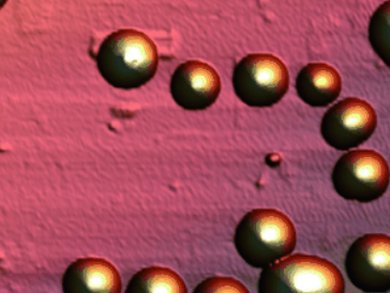Organic Nanospheres
Organic nanostructures are key elements of nanotechnology because these building blocks can be made with tailored chemical properties. Their disadvantage has been that their mechanical properties have so far been significantly inferior to those of metallic nanostructures. Ehud Gazit, Itay Rousso, and a team from the Tel Aviv University, the Weizmann Institute of Science and the Ben-Gurion University of the Negev (Israel) have now introduced organic nanospheres that are as rigid as metal. As the scientists report in the journal Angewandte Chemie, they are interesting components for ultrarigid biocomposite materials.
Nanoscale biological structures often exhibit unique mechanical properties; for example spider silk is 25 times as strong as steel by weight. The most rigid synthetic organic materials known to date are aramids, such as Kevlar. Their secret is a special spatial arrangement of their aromatic ring systems and the network of interactions between their planar amide bonds. The new nanospheres are based on a similar construction principle. However, unlike the large polymeric chains, they are formed in a self-organization process from very simple molecules based on aromatic dipeptides of the amino acid phenylalanine.
High Elasticity Modulus
Using an atomic force microscope, the scientists examined the mechanical properties of their nanospheres. This device uses a nanotip (cantilever), a tiny flexible lever arm with a very fine tip at the end. When this tip is pressed against a sample, the deflection of the lever indicates whether the tip of the needle can press into the sample object and how far in it can go. A metal needle was not able to make any impression on the nanospheres; only a needle made of diamond was able to do it. The researchers used these measurements to calculate the elasticity modulus (Young’s modulus) for the nanospheres. This value is a measure of the stiffness of a material. The larger the value, the more resistance a material has to its deformation. By using a high-resolution scanning electron microscope equipped with a nanomanipulator, it was possible to directly observe the deformation of the spheres.
For the nanospheres, the team measured a remarkably high elasticity modulus (275 GPa), which is higher than many metals and similar to the values found for steel. This makes these nanostructures the stiffest organic molecules to date; they may even eclipse aramids. In addition to having outstanding mechanical properties, the nanospheres are also transparent. This makes them ideal elements for the reinforcement of ultrarigid biocomposite materials, such as reinforced plastics for implants or materials for tooth replacement, aerospace, and other applications that require inexpensive, lightweight materials with high stiffness and unusual stability.
- Self-Assembled Organic Nanostructures with Metallic-Like Stiffness
L. Adler-Abramovich, N. Kol, I. Yanai, D. Barlam, R. Z. Shneck, E. Gazit, I. Rousso,
Angew. Chem. Int. Ed. 2010, 49.
DOI: 10.1002/anie.201002037 - L. Adler-Abramovich, N. Kol, I. Yanai, D. Barlam, R. Z. Shneck, E. Gazit, I. Rousso,
Angew. Chem. 2010, 122.
DOI: 10.1002/ange.201002037




